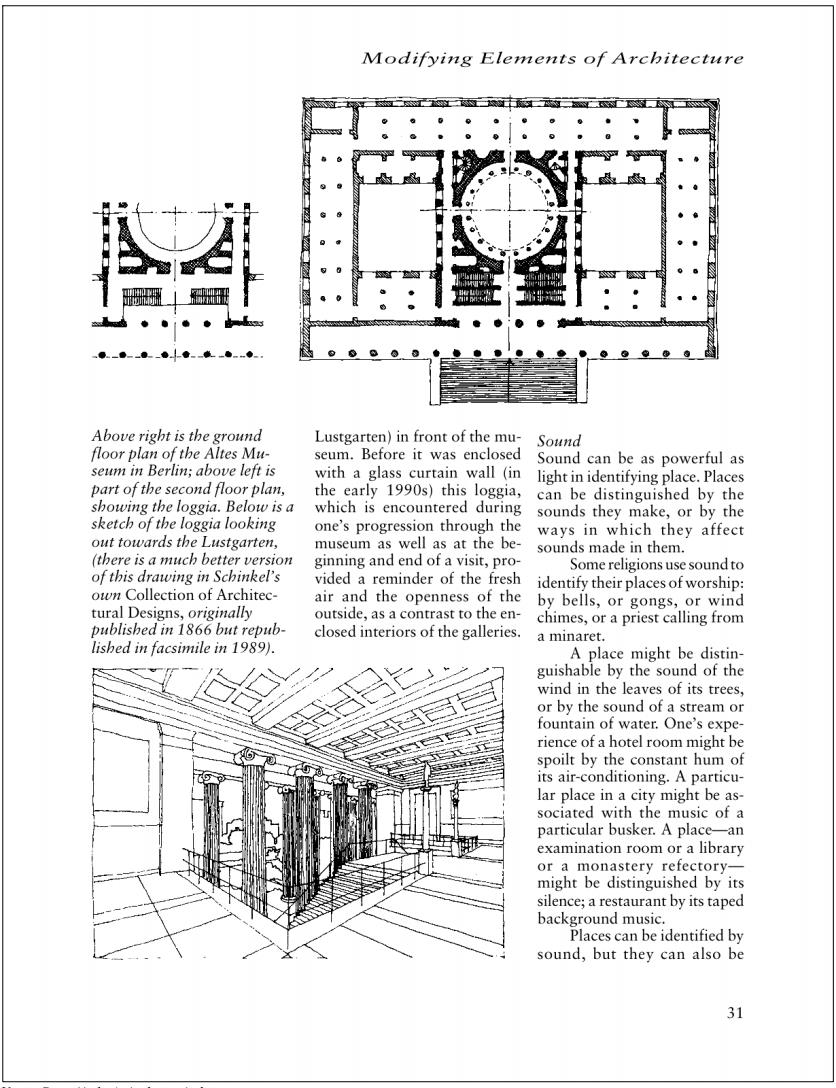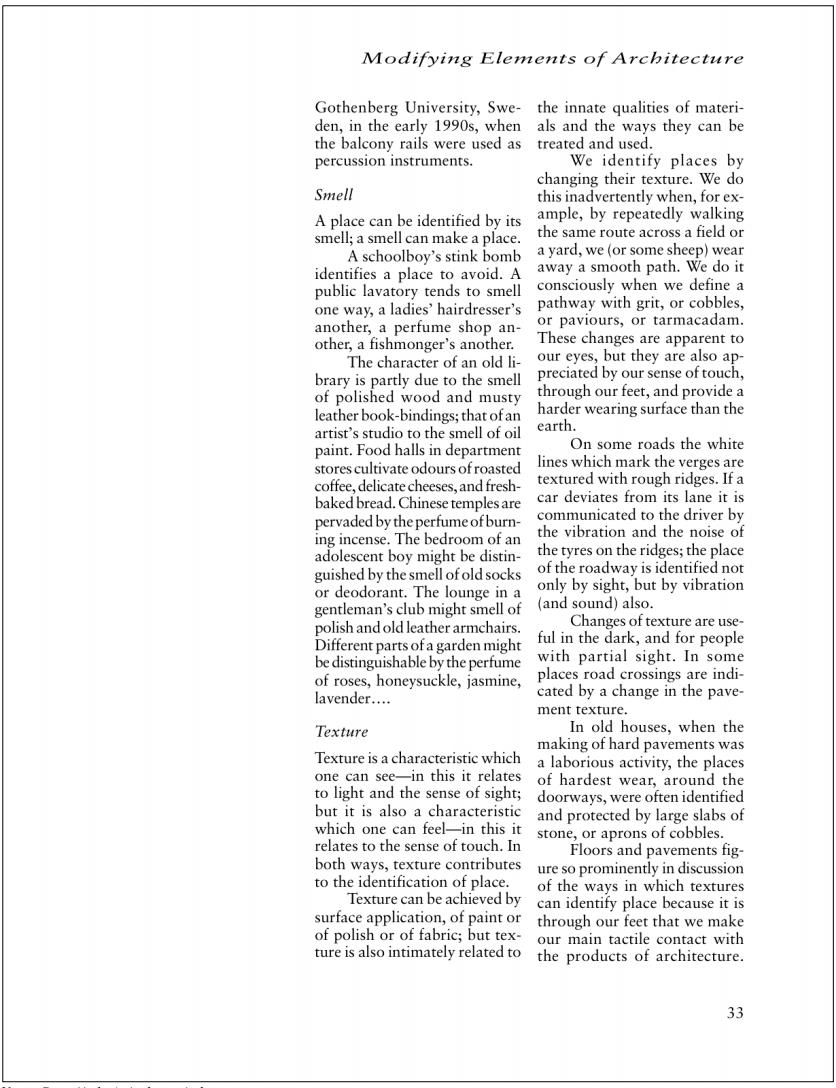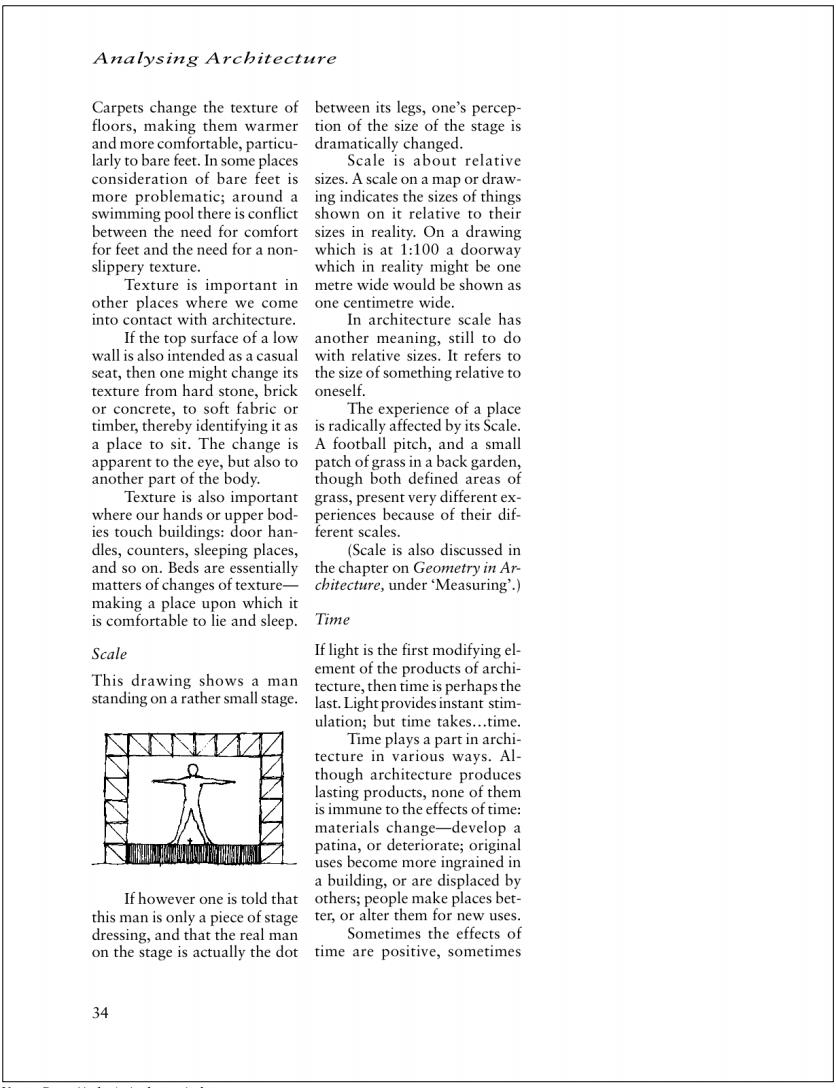
Analysing Architecture an igloo is to organise a small Ventilation place of relative warmth Temperature is involved with amidst the snowfields of the ventilation and humidity.To- arctic north. gether they can identify places A reason for the shaded which may be warm,dry,and patios,full of plants,in the still;cold,damp,and draughty; houses of Cordoba,is that they warm,humid,and still;cold, The small courtyards create a relatively cool place as dry,and draughty;and so on. (patios)of bouses in southern a respite from the heat of south- A fresh breezy place can be Spain are shaded by their high ern Spain. refreshing after a warm,humid walls and,when the sun is at Temperature has always one;a warm,still place is wel- its highest,by awnings.They been a central consideration of come after a cold windy one. are packed with many plants, architecture when thought of as In the ancient palaces of the and maybe a small fountain. identification of place. Mediterranean island of Crete, Evaporation from these Temperature may or may which has a hot,dry climate, creates cool air which flows not be associated with light.In royal apartments had open ter- through the rooms and into the temperate zones of the racesandtiny courtyards shaded the narrow streets. northern hemisphere a south from sun,and positioned to facing wall can make a place catch or produce air movement which is both bright and warm to cool the interior spaces. The residential quarters in from the light and heat of the the palaces of ancient Crete sun.An air-conditioning outlet, were well shaded.They were however,which emits no light, also provided with many can identify an attractively openings and small light wells warm place on an icy day.A which,by providing ventila- tion,helped keep the rooms bright room can of course be cool in the severe Cretan cold;a dark one warm. summer heat.(This is part of The interiors of some build- the palace of Knossos.) ings(recent art galleries for ex- ample)have constant,unvarying An air-conditioning outlet temperature in all parts,care- can identify a warm place to fully controlled by air-condition- stand on a cold day. ing and computer systems. In other buildings,a ram- bling old house for example, there may be places with differ- ent temperatures:a warm place by a fire,a cool hallway,a warm attic,a cool cellar,a warm liv- ing room,a cool passageway,a warm courtyard,a cool pergola In the front elevation of or verandah,a warm conserva- the Altes Museum in Berlin, tory,a cool larder,a hot kitchen designed by Karl Friedrich oven,a cold ice-house...;mov- Schinkel in the nineteenth cen- ing from place to place one tury,there is a loggia,once passes through zones of differ- open to the outdoor air,con- ent temperatures,related to dif- taining a pair of stairs from ferent purposes and providing ground to first floor,and look- different experiences. ing over the square (the 30
Copyright ?1997. Routledge. All rights reserved. May not be reproduced in any form without permission from the publisher, except fair uses permitted under U.S. or applicable copyright law. Unwin, Simon(Author). Analysing Architecture. London, UK: Routledge, 1997. p 30. http://site.ebrary.com/lib/sjtu/Doc?id=10057283&ppg=31

Modifying Elements of Architecture Above right is the ground Lustgarten)in front of the mu- Sound floor plan of the Altes Mu- seum.Before it was enclosed Sound can be as powerful as seum in Berlin;above left is with a glass curtain wall (in light in identifying place.Places part of the second floor plan, the early 1990s)this loggia, can be distinguished by the showing the loggia.Below is a which is encountered during sounds they make,or by the sketch of the loggia looking one's progression through the ways in which they affect out towards the Lustgarten, museum as well as at the be- sounds made in them. (there is a much better version ginning and end of a visit,pro- Some religions use sound to of this drawing in Schinkel's vided a reminder of the fresh identify their placesof worship: otn Collection of Architec- tural Designs,originally air and the openness of the by bells,or gongs,or wind outside,as a contrast to the en- chimes,or a priest calling from published in 1866 but repub- closed interiors of the galleries. a minaret. lished in facsimile in 1989). A place might be distin- guishable by the sound of the wind in the leaves of its trees, or by the sound of a stream or fountain of water.One's expe- rience of a hotel room might be spoilt by the constant hum of its air-conditioning.A particu- lar place in a city might be as- sociated with the music of a particular busker.A place-an examination room or a library or a monastery refectory- might be distinguished by its silence;a restaurant by its taped background music. Places can be identified by sound,but they can also be 31
Copyright ?1997. Routledge. All rights reserved. May not be reproduced in any form without permission from the publisher, except fair uses permitted under U.S. or applicable copyright law. Unwin, Simon(Author). Analysing Architecture. London, UK: Routledge, 1997. p 31. http://site.ebrary.com/lib/sjtu/Doc?id=10057283&ppg=32

Analysing Architecture identified by the ways in which court;the other eight circles they affect sounds made within form the galleries and entrance them. lobby.Each of the galleries has A sound in a cathedral a shallow domed roof.At the which is large and with hard centre ofeach gallery one's voice surfaces,will echo.A sound in seems amplified,as the circular a small room with a carpet,soft surfaces of the walls,and the upholstered furniture and cur-spherical surface of the domed tained windows,will be muf-ceiling,reflect it directly back. If you stand at the centre of one fled.A hall for the performance A related effect occurs in of the galleries in this building of music,or one for drama,or an amphitheatre.If one stamps by Philip Johnson,your voice is a courtroom in which wit-at the central focus,the sound reflected back to you by the nesses,lawyers and judges must reflects back from each step in curved surfaces of the walls and the ceiling,making it sound be heard,has to be made with turn,producing a very rapid louder than elsewbere. careful consideration of the 'machine-gun'sound. quality of sound it will allow. In the large church which is part of the monastery of La Tourette (the same church which has the rectangular roof- light),Le Corbusier has created a space which seems to hum of its own volition:its hard paral- lel concrete surfaces reflect,and even seem to magnify,every small noise-someone's shoe scraping on the floor,someone clearing their throat.When the monks sang in this space.... Sometimes odd acoustic ef- fects can be produced inadvert- Some composers have writ- Standing at the centre of ently.In the early 1960s the American architect Philip ten music specially to exploit the an amphitheatre,a sound is Johnson designed a small art acoustic effects of particular reflected back from each tier gallery as an extension to a buildings.The sixteenth-century in turn,extending it into a composer Andrea Gabrieli string of echoes which sound house.Its plan is based on nine circles arranged in a square;the wrote music especially for the like a rapid machine-gun. central circle is a small open cathedral of St Mark's in Ven- ice.For his Magnificat he would position three choirs and an or- chestra in different parts of the church,producing a quadro- phonic effect. There have also been oc- casions when the fabric of a building has been used as a musical instrument:this hap- pened apparently at the open- ing of an arts building at 32
Copyright ?1997. Routledge. All rights reserved. May not be reproduced in any form without permission from the publisher, except fair uses permitted under U.S. or applicable copyright law. Unwin, Simon(Author). Analysing Architecture. London, UK: Routledge, 1997. p 32. http://site.ebrary.com/lib/sjtu/Doc?id=10057283&ppg=33

Modifying Elements of Architecture Gothenberg University,Swe-the innate qualities of materi- den,in the early 1990s,when als and the ways they can be the balcony rails were used as treated and used. percussion instruments. We identify places by changing their texture.We do Smell this inadvertently when,for ex- A place can be identified by its ample,by repeatedly walking smell;a smell can make a place. the same route across a field or A schoolboy's stink bomb a yard,we (or some sheep)wear identifies a place to avoid.A away a smooth path.We do it public lavatory tends to smell consciously when we define a one way,a ladies'hairdresser's pathway with grit,or cobbles, another,a perfume shop an- or paviours,or tarmacadam. other,a fishmonger's another. These changes are apparent to The character of an old li- our eyes,but they are also ap- brary is partly due to the smell preciated by our sense of touch, of polished wood and musty through our feet,and provide a leather book-bindings;that of an harder wearing surface than the artist's studio to the smell of oil earth. paint.Food halls in department On some roads the white stores cultivate odours of roasted lines which mark the verges are coffee,delicate cheeses,and fresh- textured with rough ridges.If a baked bread.Chinese temples are car deviates from its lane it is pervaded by the perfume of burn- communicated to the driver by ing incense.The bedroom of an the vibration and the noise of adolescent boy might be distin- the tyres on the ridges;the place guished by the smell of old socks of the roadway is identified not or deodorant.The lounge in a only by sight,but by vibration gentleman's club might smell of (and sound)also. polish and old leather armchairs. Changes of texture are use- Different parts of a garden might ful in the dark,and for people be distinguishable by the perfume with partial sight.In some of roses,honeysuckle,jasmine, places road crossings are indi- lavender.... cated by a change in the pave- ment texture. Texture In old houses,when the making of hard pavements was Texture is a characteristic which a laborious activity,the places one can see-in this it relates of hardest wear,around the to light and the sense of sight; doorways,were often identified but it is also a characteristic and protected by large slabs of which one can feel-in this it stone,or aprons of cobbles. relates to the sense of touch.In Floors and pavements fig- both ways,texture contributes ure so prominently in discussion to the identification of place. of the ways in which textures Texture can be achieved by can identify place because it is surface application,of paint or through our feet that we make of polish or of fabric;but tex- our main tactile contact with ture is also intimately related to the products of architecture. 33
Copyright ?1997. Routledge. All rights reserved. May not be reproduced in any form without permission from the publisher, except fair uses permitted under U.S. or applicable copyright law. Unwin, Simon(Author). Analysing Architecture. London, UK: Routledge, 1997. p 33. http://site.ebrary.com/lib/sjtu/Doc?id=10057283&ppg=34

Analysing Architecture Carpets change the texture of between its legs,one's percep- floors,making them warmer tion of the size of the stage is and more comfortable,particu-dramatically changed. larly to bare feet.In some places Scale is about relative consideration of bare feet is sizes.A scale on a map or draw- more problematic;around a ing indicates the sizes of things swimming pool there is conflict shown on it relative to their between the need for comfort sizes in reality.On a drawing for feet and the need for a non-which is at 1:100 a doorway slippery texture. which in reality might be one Texture is important in metre wide would be shown as other places where we come one centimetre wide. into contact with architecture. In architecture scale has If the top surface of a low another meaning,still to do wall is also intended as a casual with relative sizes.It refers to seat,then one might change its the size of something relative to texture from hard stone,brick oneself. or concrete,to soft fabric or The experience of a place timber,thereby identifying it as is radically affected by its Scale. a place to sit.The change is A football pitch,and a small apparent to the eye,but also to patch of grass in a back garden, another part of the body. though both defined areas of Texture is also important grass,present very different ex- where our hands or upper bod- periences because of their dif- ies touch buildings:door han- ferent scales. dles,counters,sleeping places, (Scale is also discussed in and so on.Beds are essentially the chapter on Geometry in Ar- matters of changes of texture- chitecture,under 'Measuring'.) making a place upon which it is comfortable to lie and sleep. Time Scale If light is the first modifying el- ement of the products of archi- This drawing shows a man tecture,then time is perhaps the standing on a rather small stage. last.Light provides instant stim- ulation;but time takes...time. Time plays a part in archi- tecture in various ways.Al- though architecture produces lasting products,none of them is immune to the effects of time: materials change-develop a patina,or deteriorate;original uses become more ingrained in a building,or are displaced by If however one is told that others;people make places bet- this man is only a piece of stage ter,or alter them for new uses. dressing,and that the real man Sometimes the effects of on the stage is actually the dot time are positive,sometimes 34
Copyright ?1997. Routledge. All rights reserved. May not be reproduced in any form without permission from the publisher, except fair uses permitted under U.S. or applicable copyright law. Unwin, Simon(Author). Analysing Architecture. London, UK: Routledge, 1997. p 34. http://site.ebrary.com/lib/sjtu/Doc?id=10057283&ppg=35